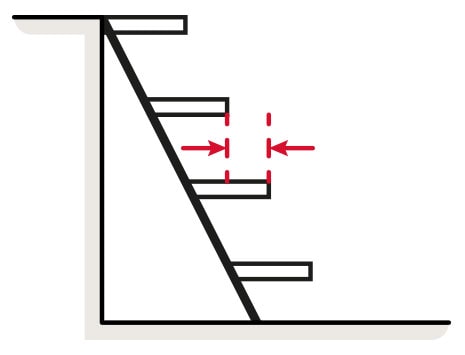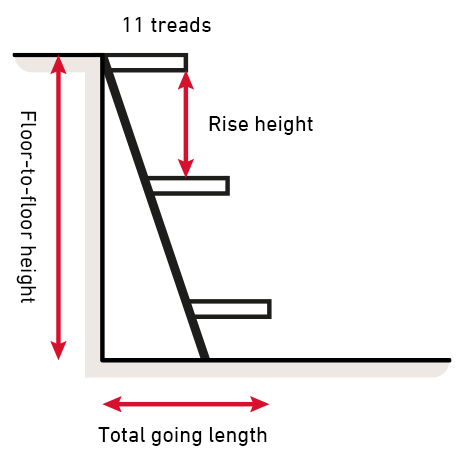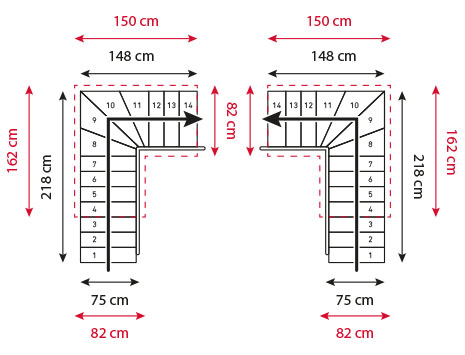MEASURING FOR A STAIRCASE
The 5 important measurements when you buy a staircase - additional GUIDE below




Upper floor opening length


Upper floor opening width


Height floor-to-floor


Height floor-to-ceiling


Total going (available floor space)
NEW STAIRCASE - WHAT IS YOUR NEED ?
To find the right stair you need to decide whether the staircase should be space saving and how much. The more space saving a staircase becomes, the less comfort the stairs will typically have. In addition, you need to decide what course the stairs should have – straight flight, quarter turn (L-shape) or half turn (U-shape).
Straight flight stairs can be very space saving and at the same time keep a good comfort by having paddle treads / reversible steps. The quarter- and half turn stairs can also give a good space saving solution and at the same time keep a good going and comfort when walking the staircase. If you want a very space saving staircase, the going may be less than 16 cm, but nevertheless with paddle treads you get a comfortable going. Be aware that the going (foot room) also have an impact on how much space the stair will take up in the room, this measurement is called total going length.

Straight flight

Quarter turn

Half turn

Turn
Stairs with quarter-turn and half-turn must always be mounted against a wall.
For the modular staircases, the wall bracket must always be used. For straight flight modular staircases, the use of the wall bracket is optional.
|
The going of a stair is the foot room you have on the tread surface when you go down the stair. As shown in the drawing, it is from the leading edge of the tread to the leading edge of the tread below. |
 |




MEASUREMENT OF FLOOR-TO-FLOOR HEIGHT
Start by figuring out how high the staircase should be. Here you need to measure from (finished floor) ground floor to finished floor on 1st floor. As shown on the drawing.
|
If your floor height is 270 cm, you can choose a staircase with 11, 12 and 13 treads. More treads provide a lower rise height of the staircase. If you want a comfortable staircase to climb, you should choose a rise height in the range of 18 - 21 cm. If you want the stairs to take up less space in the room, you can choose a higher rise. At a high rise you will find that the staircase is steeper to climb. |
 |
MEASUREMENT OF STAIRWAY OPENING
If you already have a floor opening, then measure the total width and total length. The width of your stair opening will determine which staircase may suit your project.
If you do not have an stair opening yet, then you are free to pick the staircase you want and make opening size according to your dimensions. Under each staircase on our website you can find the Dimensions under the tab "Downloads" pick, the PDF "Dimensions". In the PDF you will find the opening size (lenght and width) for the staircase you want.
|
In this e.g. we have a quarter turn stair with 14 treads. |
 |




MEASUREMENT OF DECK THICKNESS
Take the measurement from ground floor ceiling to finished floor on first floor, like on the drawing.
|
Please see the mounting instruction. |
SLANTED CEILING
Slanted ceilings can affect the headroom of the stairs and the end of the handrail banister on next level floor.
Tip: Draw the stairs on the floor with paint tape and then draw the steps on the wall and make a check measure for the headroom.


